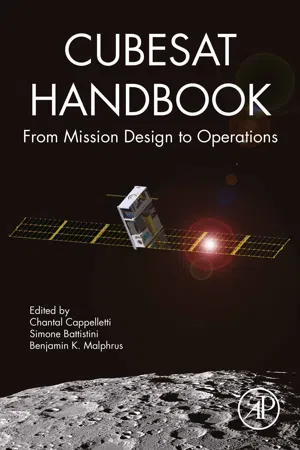
CubeSat Handbook
From Mission Design to Operations
Chantal Cappelletti,Simone Battistini,Benjamin K. Malphrus
- 498 páginas
- English
- ePUB (apto para móviles)
- Disponible en iOS y Android
CubeSat Handbook
From Mission Design to Operations
Chantal Cappelletti,Simone Battistini,Benjamin K. Malphrus
Información del libro
CubeSat Handbook: From Mission Design to Operations is the first book solely devoted to the design, manufacturing, and in-orbit operations of CubeSats. Beginning with an historical overview from CubeSat co-inventors Robert Twiggs and Jordi Puig-Suari, the book is divided into 6 parts with contributions from international experts in the area of small satellites and CubeSats. It covers topics such as standard interfaces, on-board & ground software, industry standards in terms of control algorithms and sub-systems, systems engineering, standards for AITV (assembly, integration, testing and validation) activities, and launch regulations.
This comprehensive resource provides all the information needed for engineers and developers in industry and academia to successfully design and launch a CubeSat mission.
- Provides an overview on all aspects that a CubeSat developer needs to analyze during mission design and its realization
- Features practical examples on how to design and deal with possible issues during a CubeSat mission
- Covers new developments and technologies, including ThinSats and PocketQubeSats
Preguntas frecuentes
Información
Introduction
Abstract
Keywords
1: Introduction
- • The INCOSE Systems Engineering Handbook: “Systems engineering is an interdisciplinary approach and means to enable the realization of successful systems. Successful systems must satisfy the needs of its customers, users, and other stakeholders.”
- • The NASA Systems Engineering Handbook: “at NASA, ‘systems engineering’ is defined as a methodical, multidisciplinary approach for the design, realization, technical management, operations, and retirement of a system. A ‘system’ is the combination of elements that function together to produce the capability required to meet a need. The elements include all hardware, software, equipment, facilities, personnel, processes, and procedures needed for this purpose.”
- • ESA ECSS E-10 Part 1B: “Systems engineering is the interdisciplinary approach governing the total technical effort to transform a requirement into a system solution.”